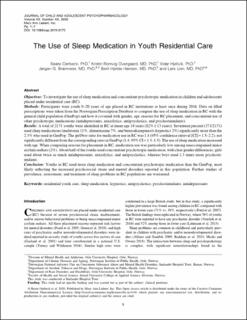The use of sleep medication in youth residential care
Ørbeck, Beate; Øvergaard, Kristin Romvig; Hjellvik, Vidar; Bramness, Jørgen Gustav; Hansen, Berit M Hjelde; Lien, Lars
Peer reviewed, Journal article
Published version
Permanent lenke
https://hdl.handle.net/11250/2648595Utgivelsesdato
2020Metadata
Vis full innførselSamlinger
Sammendrag
Objectives: To investigate the use of sleep medication and concomitant psychotropic medication in children and adolescents placed under residential care (RC). Methods: Participants were youth 0–20 years of age placed in RC institutions at least once during 2016. Data on filled prescriptions were taken from the Norwegian Prescription Database to compare the use of sleep medication in RC with the general child population (GenPop) and how it covaried with gender, age, reasons for RC placement, and concomitant use of other psychotropic medications (antidepressants, anxiolytics, antipsychotics, and psychostimulants). Results: A total of 2171 youths were identified in RC at mean age 14 years (82% ‡ 13 years). Seventeen percent (371/2171) used sleep medications (melatonin 11%, alimemazine 7%, and benzodiazepines/z-hypnotics 2%) significantly more than the 2.3% who used in GenPop. The girl/boy ratio for medication use in RC was 1.8 (95% confidence interval [CI] = 1.5–2.2), not significantly different from the corresponding ratio in GenPop (1.4; 95% CI = 1.3–1.5). The use of sleep medication increased with age. When comparing reasons for placement in RC, medication use was particularly low among unaccompanied minor asylumseekers (2%). About half of the youths used concomitant psychotropic medication, with clear gender differences; Girls used about twice as much antidepressants, anxiolytics, and antipsychotics, whereas boys used 1.3 times more psychostimulants. Conclusion: Youths in RC used more sleep medication and concomitant psychotropic medication than the GenPop, most likely reflecting the increased psychosocial strain and mental disorders reported in this population. Further studies of prevalence, assessment, and treatment of sleep problems in RC populations are warranted.
